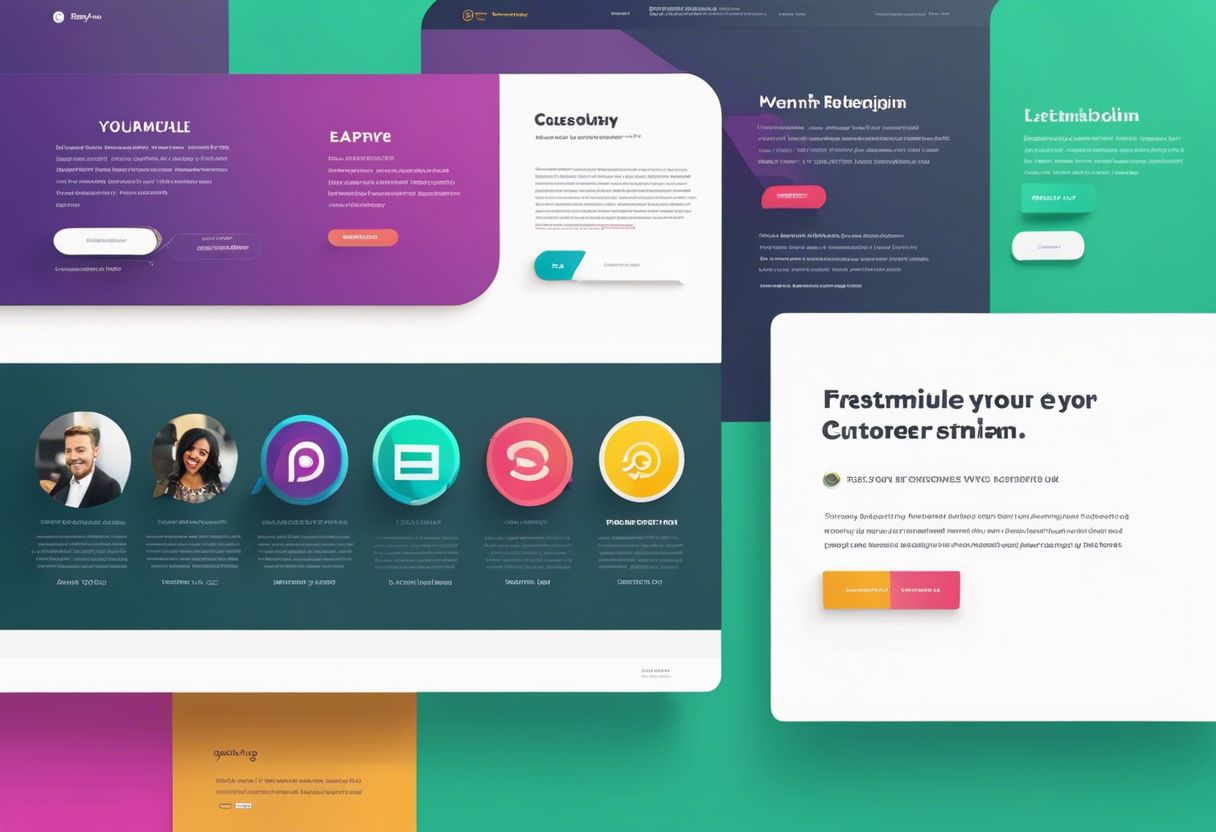Build For Success: Strategies To Convert Visitors Into Customers

Hey business owners! Building a successful brand is about turning people who visit your site into customers. This means having something special that only you offer, or a “Unique Selling Proposition.” It’s like telling everyone why they should pick you and not the other shop.
You also need to make sure when people come to your website, they stick around and talk to you. Some businesses use things like live chat because it helps sell more.
Your website should be easy for people to use, get what they need quickly, and never have to wait too long for pages to load. Did you know if your site is slow by just a tiny bit, 7% more people leave without looking at anything? That’s bad for business!
Next up, let customer stories do some talking. When new customers see good reviews or badges that say you’re great, they’re more likely to buy from you. And don’t forget emails! Sending the right kind of email can really help turn someone just looking around into someone buying.
Of course, testing out different ideas on your site will show what works best. Plus tapping into cool trends like talking searches on phones gets even more customers noticing you.
Let’s start building success with smart moves that bring in those sales! Keep reading; we’ve got lots of helpful tips ahead!
Understanding Your Unique Selling Proposition

Identifying your unique selling proposition is crucial in setting yourself apart from the competition. By effectively communicating your brand’s value, you can capture the attention and interest of potential customers, ultimately leading to higher conversion rates.
Identifying your value proposition

We know how important it is to stand out from the crowd. That’s why we dig deep into what makes our products special and why customers should pick us over anybody else. Our value proposition is like a promise that tells you exactly what you’ll get when you choose our brand.
It’s not just about being different; it’s about showing how we can make your life better in ways others can’t.
Our job is to make sure you understand the key selling points of what we offer. We look at all the good stuff that comes with our product, like quality, price, and service, and then explain this clearly so you see the real benefits for yourself.
This way, when you compare us with other options out there, it’s super clear why we’re the best choice.
Let’s talk plainly — your trust means everything to us, so we lay out our brand promise without any fancy jargon or tricky language. Next up: Communicating your brand effectively!
Communicating your brand effectively

After figuring out what makes our product special, it’s time to share that with the world. Our brand is like a promise to our customers; it tells them what they can expect from us.
We need to tell them clearly how we’re different and better than others.
Our words matter a lot here. We must talk about our unique selling proposition in a way that feels important to our customer. They should quickly see why they would choose us over someone else.
For example, if we sell bikes that last longer than any other bike, we say just that – “Our bikes ride strong year after year.”.
We keep working on this message until it’s easy for everyone to get what we mean right away. The goal is for people to think of those strong, long-lasting bikes as soon as they hear about our brand! This clear communication builds trust and sets the stage for turning visitors into loyal customers who believe in what we offer.
Optimizing Visitor Engagement
 Implementing live chat and chatbots can provide real-time assistance to visitors, increasing their engagement with your website. Using pop-ups and exit-intent offers strategically can also prompt visitors to take action and convert into customers.
Implementing live chat and chatbots can provide real-time assistance to visitors, increasing their engagement with your website. Using pop-ups and exit-intent offers strategically can also prompt visitors to take action and convert into customers.
Implementing live chat and chatbots

We understand that engaging with your visitors is key to turning them into customers. Live chat and chatbots can make this happen by offering personalized customer interactions and instant support. Here’s how we can put these tools to work:
- Identify the best spots on your website to place live chat windows. Think about where visitors have questions or might need help, like on product pages or at checkout.
- Train your live chat team to answer questions quickly and accurately. This makes sure visitors get the help they need right away.
- Set up chatbots to handle common questions 24/7. Even when we’re not online, our visitors can get answers.
- Personalize chat conversations with the visitor’s name and past interactions. This shows we remember them and value their time.
- Use chatbots for proactive customer messaging. They can reach out first to offer help or share info about orders, making customers feel cared for.
- Review chats regularly to find ways to improve. We’ll see what questions come up a lot and update our website or products based on what people ask.
Using pop-ups and exit-intent offers strategically

After implementing live chat and chatbots to engage visitors, it’s important to strategically use pop-ups and exit-intent offers to further enhance customer conversion. Here are some impactful strategies and techniques:
- Employ Exit-Intent Popups: Utilize exit-intent technology to offer compelling content, discounts, or freebies just as visitors are about to leave your site. This can entice them to stay and explore further.
- Offer Value with Popup Offers: Ensure that the pop-up offers provide real value to visitors, such as exclusive deals, helpful resources, or additional information related to their interests or needs.
- Create Mobile-Friendly Popups: Optimize pop-ups for mobile users by ensuring they display correctly on smaller screens without hindering the user experience.
- Tailor Popup Content: Personalize popup content based on visitor behavior or their stage in the customer journey for a more targeted and effective approach.
- Strategically Time Popups: Implement pop-ups at opportune moments during a visitor’s interaction with your website, such as after spending a certain amount of time on a page or when they exhibit intent to exit.
- A/B Test Popup Designs: Experiment with different designs, messaging, and visuals for pop-ups using A/B testing to determine the most effective approach for your audience.
- Avoid Overwhelming Visitors: Be mindful not to inundate visitors with too many pop-ups that may detract from their overall experience on the site.
Enhancing Website Experience

“Building a user-friendly interface is crucial for keeping visitors engaged and satisfied. Streamlining navigation for ease of use and accelerating website load times are essential components of creating an exceptional website experience.”.
Building a user-friendly interface

We know that building a user-friendly interface is crucial for enhancing website experience and increasing conversion rates. Here are key strategies to achieve this:
- Ensure clear and intuitive website navigation to guide visitors seamlessly through the site.
- Simplify the design and layout for easy visual understanding, reducing clutter and distractions.
- Use plain language and avoid technical jargon to make content easily comprehensible.
- Optimize the website for various devices, ensuring a consistent user experience across different platforms.
- Implement interactive elements such as buttons and forms to engage users and encourage interaction.
- Prioritize fast loading times by optimizing images, minimizing code, and leveraging caching techniques.
Streamlining navigation for ease of use

After building a user-friendly interface, it is essential to streamline navigation for ease of use. This is vital as seamless browsing and an intuitive design can significantly enhance the overall user experience. Here are some strategies to achieve optimal navigation on your website:
- Implement clear and logically structured menus to guide visitors effortlessly through your site.
- Use descriptive labels and concise wording to aid comprehension of navigational elements.
- Ensure that important links and calls-to-action are prominently displayed for quick access.
- Optimize for mobile navigation, ensuring consistency in user experience across different devices.
- Minimize the number of clicks required to reach key pages or products, simplifying the browsing process.
- Integrate search functionality that delivers relevant results swiftly, enhancing user satisfaction.
Accelerating website load times

To further enhance the website experience, it is crucial to prioritize accelerating website load times. Research shows that a one-second delay in load time can result in decreased customer acquisition and increased bounce rates.
Visitors expect a page to load in two seconds or less, therefore optimizing website speed is essential for meeting user expectations and ultimately increasing conversion rates. A B2B site that loads in 1 second has a conversion rate 3x higher than a site that takes 5 seconds to load.
Thus, improving website performance not only enhances user experience but also reduces bounce rates and customer acquisition costs.
Considering these factors, enhancing website efficiency through minimizing page load times becomes instrumental in achieving our goal of converting visitors into customers while ensuring they have a seamless online experience.
Leveraging Social Proof and Testimonials

Showcasing positive customer reviews and success stories on your website can build trust and credibility with potential customers. Utilize trust badges and endorsements to further enhance the reputation of your brand and products.
Showcasing customer reviews and success stories
We know that showcasing customer reviews and success stories can be influential in attracting new customers and increasing sales. Here are some practical ways to utilize this strategy:
- Display a variety of positive customer feedback, including testimonials and user-generated content, on your website to build trust and credibility with potential customers.
- Share in – depth customer success stories that provide real accounts of how customers used your product or service and the results they achieved. These stories can be influential in inspiring buying decisions.
- Utilize influential endorsements or validation such as trust badges, awards, or recognitions to further build trust with potential customers.
- Encourage satisfied customers to share their positive experiences on social media platforms, leveraging social proof to influence purchasing decisions.
- Use before-and-after images or videos to visually showcase the impact of your product or service on real customers, further validating its effectiveness.
- Highlight any partnerships or collaborations with well – respected individuals or organizations that endorse your brand, enhancing credibility and trustworthiness.
- Incorporate customer quotes or snippets from reviews within your marketing materials or product pages to reinforce the value and benefits of your offerings.
Utilizing trust badges and endorsements
Showcasing customer reviews and success stories establishes social proof, but utilizing trust badges and endorsements can further enhance your brand’s credibility. These visual representations of trust act as certifiable proofs from reputable sources, solidifying your position in the market.
By displaying these trust badges prominently on your website, you’re assuring potential customers of reliability and building a trustworthy image for your brand. Including endorsements from industry leaders or well-known personalities can also reinforce the sense of authority around your products or services, ultimately influencing potential customers’ buying decisions through these validated recommendations.
Endorsements
Trustworthiness
Credibility
Email Marketing and Lead Nurturing

Crafting a compelling email list and segmenting it for targeted campaigns is crucial for lead nurturing. Employing drip email strategies can help maintain engagement over time, ultimately leading to more conversions.
Creating a compelling email list
To create a compelling email list, we focus on attracting quality subscribers who are genuinely interested in what we offer. This involves providing valuable content or incentives to encourage visitors to sign up for our emails.
By offering something of value, such as exclusive discounts or helpful resources, we can entice our website visitors to subscribe to our list. Once they’re subscribed, it’s vital to keep them engaged with relevant and personalized content that meets their needs and interests.
Segmenting our email list enables us to send targeted campaigns based on subscriber preferences and behavior. By understanding the different segments within our audience, we can tailor our messages accordingly, making them more effective and useful for the recipients.
Additionally, employing drip email strategies allows us to nurture leads by sending a series of automated emails designed to guide potential customers through the purchasing decision process.
These strategies help build a solid foundation for turning subscribers into loyal customers while increasing engagement and conversion rates.
Segmenting lists for targeted campaigns
Segmenting email lists can lead to higher conversions and more targeted campaigns. Email segmentation involves breaking email recipients into smaller, targeted groups to send them the most relevant content.
- Customer Segmentation: Divide your subscriber lists based on demographics, purchase history, and engagement level to ensure personalized messaging for each group.
- Personalized Content: Tailor your email campaigns with content that resonates with each segmented group’s interests and needs.
- Relevant Messaging: Craft compelling messages that speak directly to the specific segment’s pain points, desires, or behaviors.
- Targeted Marketing: Use subscriber data to create highly focused campaigns that drive better engagement and higher conversion rates.
- Best Practices: Implement industry-proven strategies for effective list segmentation such as behavior-based triggers and RFM (recency, frequency, monetary) analysis.
Employing drip email strategies
As business owners, we understand the power of employing drip email strategies in our marketing efforts. Here’s how we can leverage this technique to its fullest potential:
- Design personalized welcome drips that engage new leads from the start, making them feel valued and excited about our brand.
- Implement onboarding sequences to guide customers seamlessly through their early interactions with our products or services, ensuring a positive first experience.
- Create lead nurturing campaigns that provide valuable content and relevant information to potential customers based on their interests and behaviors.
- Develop abandoned cart emails that entice customers to return and complete their purchase by offering incentives or addressing any concerns they may have.
- Utilize automated email campaigns to deliver targeted messaging at key touchpoints in the customer journey, enhancing engagement and driving conversions.
- Employ customer segmentation to tailor our drip email content for different audience groups, ensuring maximum relevance and impact.
- Integrate behavioral targeting into our drip strategies, allowing us to deliver timely and personalized communication that resonates with individual customer actions and preferences.
- Leverage marketing automation tools to streamline our drip email processes, saving time and resources while maintaining consistent communication with leads and customers.
Conversion Optimization Techniques

Implement A/B testing to optimize your website for maximum impact, create clear and compelling calls-to-action (CTAs), and reduce cart abandonment with timely interventions. Ready to take your conversion rates to the next level? Keep reading to find out more about these powerful strategies!
A/B testing for maximum impact
We, as business owners, must understand that A/B testing is a marketing experiment used to compare two versions of a webpage or app. It helps us make data-driven decisions for maximum impact on user engagement and conversion rates. Here are nine essential A/B tests we can perform for maximum impact on website performance:
- Test different headline variations to see which one drives more user engagement and conversions.
- Experiment with various call-to-action (CTA) button colors, text, and placements to optimize conversion rates.
- Compare different images to determine which visuals resonate best with our audience and lead to higher user satisfaction.
- Try out diverse forms and lengths of content to identify the most compelling messaging that boosts conversion rates.
- Test varying layouts and designs to improve website optimization and overall user satisfaction.
- Experiment with different pricing strategies or discount offers to increase conversion rates and drive sales.
- Compare the efficiency of different pop-up or exit-intent offers in capturing leads and enhancing user engagement.
- Test the impact of personalized recommendations versus generalized product suggestions on driving conversions.
- Try out various email subject lines, content formats, and timing for our email marketing campaigns to boost open rates and click-throughs.
Clear and compelling calls-to-action (CTAs)
We have explored the significance of A/B testing for maximum impact. Now, let’s delve into the importance of clear and compelling calls-to-action (CTAs) and how they can significantly enhance visitor conversion rates.
- Impactful Language: Use persuasive language in your CTAs to prompt action. Engage visitors with compelling phrases that inspire them to take the desired steps.
- Design and Placement: Ensure that your CTAs stand out visually and are strategically placed within your content or website to capture attention effectively.
- A/B Testing Variations: Experiment with different CTA designs, texts, and placements through A/B testing to identify the most effective approach for improved conversion rates.
- Personalization and Relevance: Tailor your CTAs to be relevant to your audience, making them feel like personalized invitations rather than generic prompts.
- Trustworthiness and Clarity: Use trust badges and endorsements in conjunction with clear and transparent language in your CTAs to instill confidence in visitors.
- Consistent Branding: Maintain consistency in branding elements within your CTAs, ensuring they align with your overall brand identity for a cohesive user experience.
- Data-Driven Optimization: Utilize analytics tools to gather insights on CTA performance and make informed decisions regarding optimization strategies.
- Mobile Responsiveness: Adapt your CTAs for mobile devices by considering design elements that ensure easy visibility and interaction on smaller screens.
- Timely Interventions: Implement exit-intent pop-ups or offers strategically to re-engage visitors who are about to leave without taking action.
- Call-to-Action Copywriting: Craft engaging CTA phrases that convey a sense of urgency or exclusivity, driving immediate action from visitors.
Reducing cart abandonment with timely interventions
We can significantly reduce cart abandonment and increase conversions with timely interventions. Here are effective strategies to tackle cart abandonment:
- Implement a simplified checkout process to reduce friction and enhance the customer experience.
- Utilize intent – based incentives to nudge hesitant customers towards completing their purchase.
- Send personalized abandoned cart emails with compelling offers to re – engage potential customers.
- Use retargeting strategies across different digital channels to remind customers of their abandoned carts.
Analytics and Feedback Collection

Utilize advanced analytics tools to track and analyze user behavior, conversion rates, and website performance. Collecting feedback from customers through surveys or reviews can provide valuable insights for making strategic adjustments to improve customer conversion.
Utilizing tools for tracking and analysis
We understand that tracking and analysis are crucial for understanding customer behavior and optimizing user experience. Here are essential techniques and tools to effectively utilize for this purpose:
- Implement data analysis processes to extract valuable insights from customer interactions, website usage, and purchasing patterns.
- Utilize customer behavior tracking tools to monitor how visitors engage with your website, product pages, and marketing campaigns.
- Optimize user experience by employing feedback collection tools to gather actionable insights on pain points and areas for improvement.
- Employ CRM analytics to capture and analyze important customer data, thus enhancing the quality of customer relationships.
- Utilize sentiment analysis tools to track real-time customer sentiment, providing valuable longitudinal data on the overall customer experience.
- Implement revenue optimization techniques by analyzing purchase patterns and identifying opportunities for upselling or cross-selling.
Collecting feedback to inform strategy adjustments
We gather customer opinions and feedback through various channels like user input, community insights, and support ticket tracking. This gathered information can provide valuable insights into customer experience and help identify issues that need attention. Here are ways to collect feedback and inform strategy adjustments:
- Utilize analytics tools to track and analyze customer feedback across multiple touchpoints such as social media, online reviews, and direct communication channels.
- Categorize the collected feedback based on common themes or topics to identify recurring issues, allowing for quick and targeted resolution.
- Encourage customers to share their thoughts through surveys, testimonials, or interactive feedback forms on your website to capture diverse perspectives.
- Leverage customer support ticket history to understand recurring problems and take proactive measures in addressing them.
- Engage with customers through regular communication to build rapport and gain deeper insights into their experiences with your business.
- Monitor online community forums or discussion groups related to your industry to stay informed about broader customer sentiments and concerns.
- Implement a structured process for gathering, analyzing, and acting on customer feedback within your organization to ensure consistent improvements.
- Use feedback analysis not just as a problem – solving tool but also as a means of identifying opportunities for innovation and enhancement.
Referral and Loyalty Programs

Encouraging word-of-mouth with referral incentives and building loyalty through rewards programs are essential strategies in converting visitors into customers. By leveraging the power of existing customer relationships, businesses can drive new sales and retain loyal customers for sustained growth.
Encouraging word-of-mouth with referral incentives
As business owners, we understand the importance of encouraging word-of-mouth with referral incentives. By leveraging referral and loyalty programs, we can cultivate customer advocacy and organic referrals. To achieve this, consider the following strategies:
- Institute a Rewarding Referral Program: Incentivize your existing customers to refer friends by offering them rewards for successful referrals.
- Provide Exclusive Incentives: Offer special discounts or perks to both the referrer and the new customer to create a win-win situation.
- Cultivate Brand Advocates: Identify loyal customers who are likely to advocate for your brand and provide them with additional incentives for doing so.
- Create Shareable Content: Develop engaging and shareable content that empowers customers to spread the word about your products or services.
Building loyalty through rewards programs
Encouraging word-of-mouth with referral incentives can lead to building loyalty through rewards programs. Such programs allow customers to earn rewards by completing specific actions like social shares or referrals. Customer loyalty programs are designed to motivate customers to continue purchasing from a brand and focus on building customer relationships, converting them into long-term loyal members. Here’s how you can achieve this:
- Motivate customers with attractive incentives that align with their interests and preferences, thereby encouraging repeat purchases and strengthening brand engagement.
- Create personalized experiences for customers by using relevant information gathered from their interactions with the brand, fostering a sense of exclusivity and value in their relationship with the business.
- Implement customer feedback mechanisms within the program to continuously adapt and improve based on customer preferences and insights, ensuring that the program remains aligned with their needs and desires.
- Reward not only transactions but also other valuable interactions such as social media engagement, referrals, and advocacy, nurturing a holistic approach to customer loyalty beyond mere purchasing behavior.
- Evaluate the effectiveness of the loyalty program through analytics and feedback collection tools, allowing for continuous optimization and enhancement of the program’s impact on customer relationships and revenue generation.
Adapting to Emerging Trends and Technology in Customer Conversion (including voice search optimization)
-151538121.jpg)
As businesses, we need to be proactive in adapting to emerging trends and technology, especially voice search optimization. With the rise of voice recognition technology, user behavior is changing.
This means we must adjust our SEO tactics to accommodate conversational search queries. By understanding the digital landscape and adopting a user-centric approach, we can effectively optimize for new customer acquisition methods and enhance online visibility.
Embracing adaptation strategies is vital as voice search becomes an integral part of how potential customers find us online.
In today’s fast-paced world, optimizing for voice search is not just an option but a necessity for successful customer conversion. It allows users to perform searches with vocal inquiries on their devices and influences how they interact with businesses online.
Therefore, as business owners, it’s imperative that we prioritize this aspect of digital marketing to stay ahead in converting visitors into loyal customers.
Conclusion

In conclusion, converting website visitors into customers is a critical aspect of business success. Understanding your unique selling proposition and leveraging social proof can build trust and encourage conversions.
Optimizing visitor engagement and using conversion optimization techniques can significantly impact sales and revenue. By adapting to emerging trends and technology, businesses can stay ahead in the competitive world of online customer acquisition.
Remember, focusing on practical benefits and setting clear objectives are essential for successful customer conversion strategies.
Discover how to stay ahead of the curve by optimizing your website for voice search, and ensure you’re capturing every possible customer in today’s evolving digital landscape.


